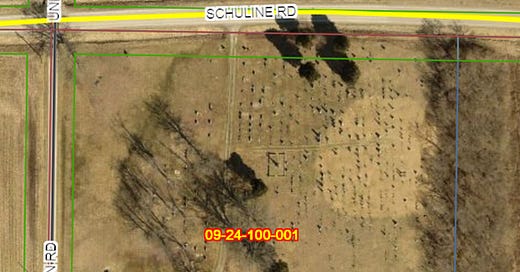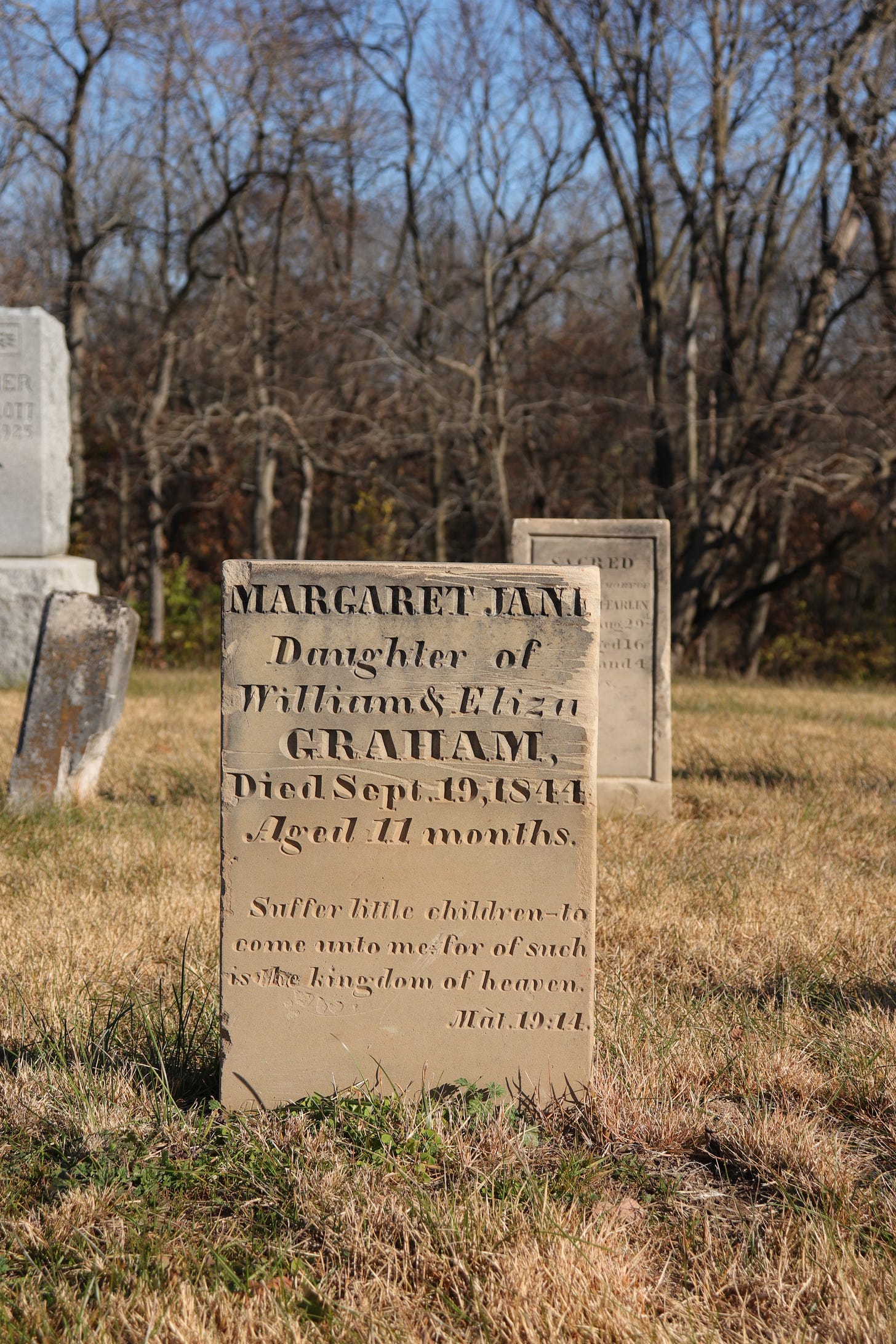I stumbled onto this image of Union Cemetery on ARCGIS recently. I had saved and filed it away some time ago. At the time it was just an aerial shot of Union Cemetery in Sparta, Illinois and rather unremarkable, or so I thought.
Aerial photo of Union Cemetery / ARCGIS
In the intervening time our cemetery restoration volunteers have made numerous repairs to the historic grave markers at Union Cemetery. And in spending so much time there, we began to see details not at first noticeable. We found birds foot violet (Viola pedata), a dainty native flower that reliably graces the cemetery turf every April; having adapted to the dry prairie soil and scalping lawn mower blade. And there are the little wood bees that buzz around at 3:00 pm on a hot summer day, making their home in the dense mat of Zoysia turf.
And there is the Zoysia grass itself. The tan colored circle in the ARCGIS image above is the area of Zoysia grass in its dormant winter phase. The above image was taken in very early spring as evidenced by the foliage, turf color and sun angle.
Birds Foot Violet
This past year we measured the size and found the radius of the Zoysia circle was about 65 feet. Since Zoysia, according to turf experts at the University of Illinois, grows about 6 inches per year, and assuming the planting was from a single plug, would mean that it was planted 130 years ago or about 1894. The exact center of this Zoysia area is where the front door of the original 1831 Union Church was, the church having been razed in the 1870s. Later, the area was leveled and used for burial plots totally obliterating evidence of the earlier Presbyterian church building.
I also found that Zoysia was introduced into N. America from Korea and Japan in 1892. So, the timeline here fits pretty well. For some reason someone planted plugs of Zoysia either to mark the spot of Union Church (doubtful) or to decorate the grave of a loved one (probable). And there are many burials in this immediate area that date from the early 1880s through 1910s.
Another possibility is that Zoysia was accidentally introduced by fill dirt brought in to level the surface after the salvaging of building materials that were used in the new church. I think this theory is unlikely given that having just been introduced in 1892 Zoysia was still a very rare plant by 1895. The most likely story is that someone decorated a family members plot with Zoysia grass circa 1895 for aesthetic reasons.
In researching zoysia grass I found that Christian burials in Korea are sometimes planted with Zoysia grass due to its dense growth habit. For those not familiar with Zoysia, a warm season rhizomatous perennial, it makes a dense green carpet choking out weeds and competing grasses. This makes sense given the desire and necessity to control vegetative growth in cemeteries before the invention of the lawn mower.
There is also the possibility of a Presbyterian missionary connection. Of the seventeen percent of S. Koreans that have converted to Christianity approximately two thirds identify as Presbyterian. This is because of the early work of Presbyterian missionaries that began in Korea in 1885. Did a Presbyterian missionary pass along some sprigs of Zoysia to a Presbyterian congregation in Illinois? There are many Presbyterian ministers and their family members buried in Union Cemetery. Commonly, a pastor would preach at Union Church for a few years and move on. This grave marker of eleven-month-old Margaret Jane Graham is a poignant reminder of this practice. Little Margaret is the only member of her family buried at Union Cem. Her father, a former pastor at Union Church moved on, eventually the family ended up in Monmouth, Illinois site of the Presbyterian affiliated Monmouth College. Margaret’s burial plot is near the center of the Zoysia circle.
Grave marker of Margaret Jane Graham 1844
Timeline
1870s – The original 1831 Presbyterian church is torn down.
1885 – First Presbyterian missionaries work in Korea
1892 – Zoysia grass introduced to N. America from Korea and Japan
1894 – Estimated year of Zoysia planting at Union Cemetery
2024 – Area occupied by Zoysia is circle 130 feet in diameter
Ultimately, this is one of those small mysteries that we will never solve. But what is certain is that humans have been altering their immediate environment in big and small ways for eons. Indians no longer burn off the Illinois prairies in pursuit of game. The vast open prairies zones are instead maintained today by industrial agriculture. The exotic (and sometimes obnoxiously invasive) plants found in cemeteries are the result of aesthetic additions of past generations. In cemeteries you can find Euonymus vines, also an Asian import as well as numerous other plants from florist shops that have gone native. The next time you are in a cemetery, look in the area where withered flowers are discarded. Chances are you will find some escaped ornamentals that have taken root in their new home. The million year long process of man altering his environment plays on.







This is interesting, David. I wonder what other subtle floras we’ve planted in other cemeteries across the US? I’ll have to keep my out the next time I go to a cemetery.
Look forward to it.